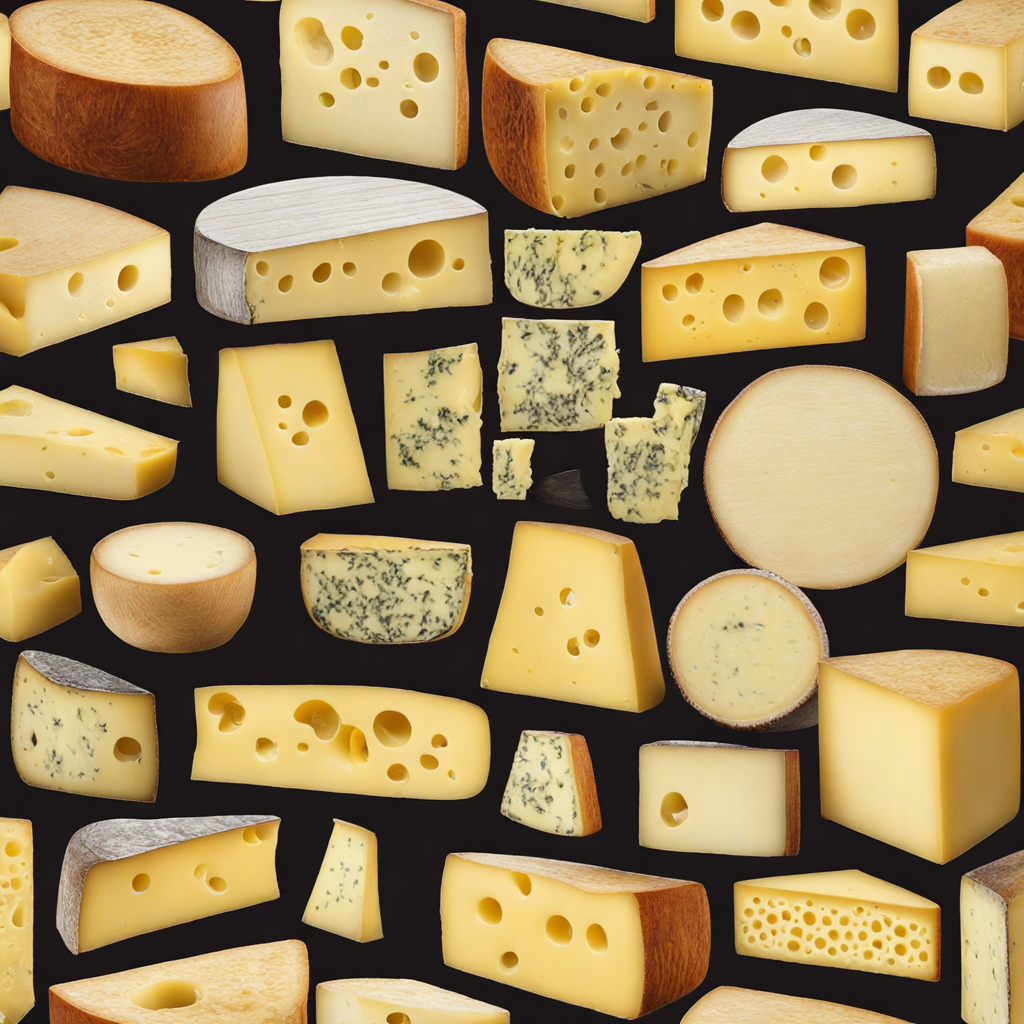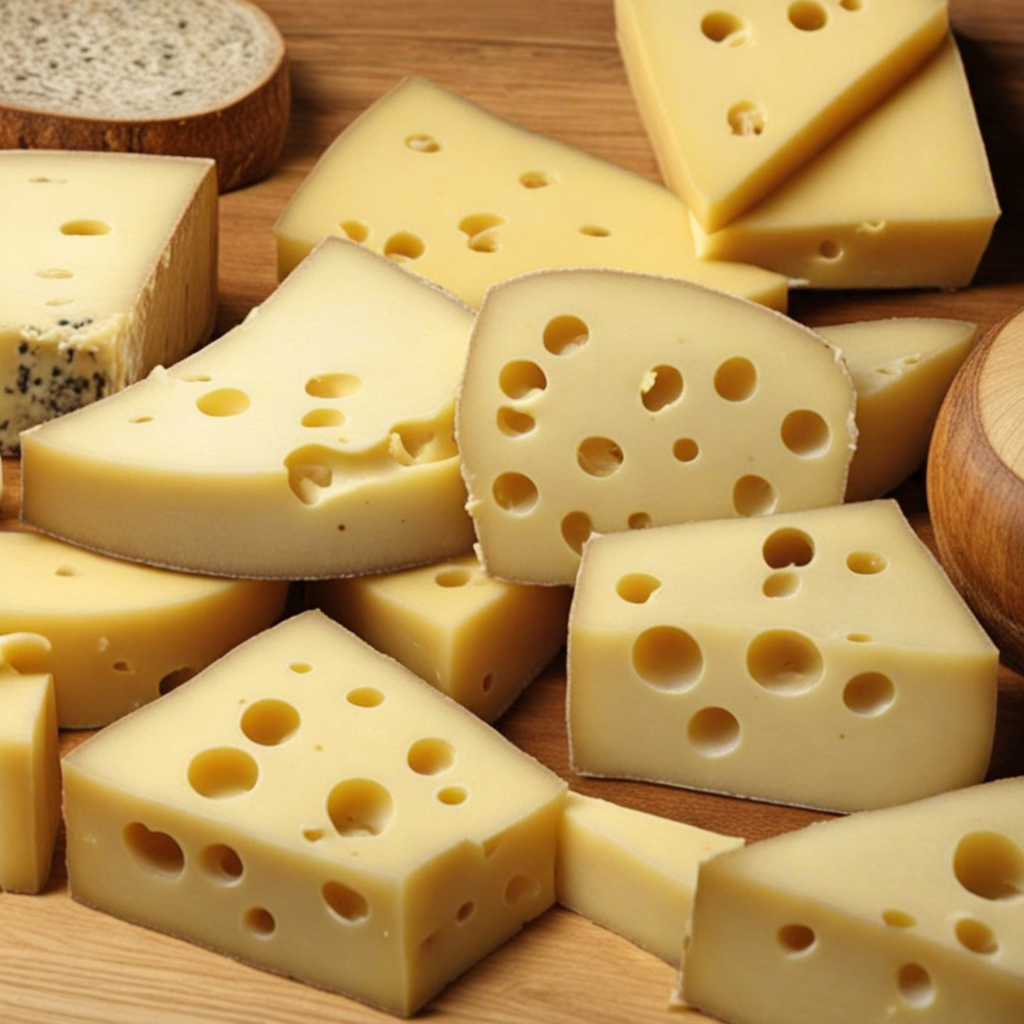Swiss Cheese
Swiss cheese, a delightful product of Switzerland, is renowned for its distinctive flavor and unique texture. This cheese is characterized by its smooth, pale yellow rind and the signature holes, or "eyes," that result from the fermentation process. The most famous varieties include Emmental, Gruyère, and Appenzeller, each offering a different taste profile. Emmental boasts a mild, nutty flavor with a slightly sweet finish, while Gruyère has a more complex taste with hints of earthiness and a touch of salt, making it perfect for fondue recipes. Appenzeller, on the other hand, is known for its spiciness, which is attributed to the herbs and spices used in its brine. Swiss cheese is versatile and can be enjoyed in numerous ways, enhancing both simple and elaborate dishes. It melts beautifully, making it an essential ingredient for Swiss fondue, where it is combined with white wine and served with crusty bread for dipping. It also shines in classic Swiss raclette, where it is melted over potatoes and served with pickles. Beyond traditional dishes, Swiss cheese can elevate salads, sandwiches, and charcuterie boards, adding a creamy texture and rich flavor that tantalizes the palate. As you explore Swiss cheese, you’ll discover its role in Swiss culture and culinary traditions. The cheese is often produced in small dairies across the picturesque Swiss Alps, where the cows graze on lush pastures, contributing to the cheese's distinct taste. Sampling Swiss cheese is not just a culinary experience but also a journey into Switzerland's heritage, reflecting the craftsmanship and dedication of local cheese makers. Whether enjoyed on its own, paired with fruits and nuts, or melted into savory dishes, Swiss cheese promises to introduce you to a world of rich flavors and delightful textures.
How It Became This Dish
The History of Schweizer Käse: Switzerland's Culinary Treasure Switzerland, a land renowned for its stunning landscapes, precision engineering, and rich cultural heritage, is equally celebrated for its cheese. Among the myriad varieties produced in this Alpine nation, Schweizer Käse—commonly known as Swiss cheese—stands out not only for its distinctive flavor but also for its rich history and cultural significance. #### Origins and Early Development The origins of Swiss cheese can be traced back to ancient times, with evidence of cheese production in Switzerland dating as far back as 2000 BC. Archaeological findings suggest that the Celts and later the Romans were among the early cheese-makers in the region, utilizing the abundant milk from the local dairy animals. By the Middle Ages, cheese-making had become a widespread agricultural practice, particularly in the Alpine regions. Monasteries played a crucial role in the development of cheese-making techniques and the refinement of recipes. For instance, the monks of the Abbey of St. Gall were instrumental in establishing the cheese-making traditions that would later define Swiss cheese. The most iconic varieties of Schweizer Käse emerged during the 16th century, with Emmental and Gruyère leading the charge. Emmental, known for its characteristic holes or "eyes," is believed to have been produced as early as the 13th century. Its name derives from the Emme River valley in the Canton of Bern, where it was first crafted. Gruyère, on the other hand, originates from the town of Gruyères and has been a staple since at least the 12th century. #### Cultural Significance Cheese is more than just a staple food in Switzerland; it is woven into the very fabric of Swiss culture and identity. The Swiss have a long-standing tradition of cheese-making, which is celebrated in numerous festivals across the country. The Alpabzug, or the descent of cattle from the mountains in autumn, is a particularly important event where farmers showcase their cheese, often made during the summer months in Alpine pastures. Moreover, Swiss cheese has become an integral part of the Swiss culinary repertoire. Fondue, a classic dish that involves melting cheese and serving it with bread, is perhaps the most famous example. It is said to have originated as a rustic meal for peasants in the mountainous regions, providing a hearty source of sustenance during harsh winters. Today, fondue is a symbol of Swiss hospitality and is enjoyed by locals and tourists alike. In addition to fondue, Swiss cheese features prominently in other traditional dishes such as Rösti (a potato dish), Älplermagronen (a Swiss version of macaroni and cheese), and Raclette—another beloved melted cheese dish that highlights the versatility of Schweizer Käse. The cheese also plays a vital role during celebrations and holidays, often gracing tables during festive occasions. #### Global Recognition and Development As the 19th century progressed, Swiss cheese gained international acclaim, thanks in part to the industrial revolution and advances in transportation. The establishment of railways allowed for easier distribution of cheese, and Swiss cheese began to find its way to markets beyond Switzerland. Swiss cheese was one of the first types of cheese to be exported on a large scale, with Emmental leading the charge due to its popularity in the United States. In the latter half of the 20th century, Swiss cheese experienced a transformation in production methods. While traditional artisanal cheese-making remained, the advent of industrial cheese production techniques allowed for mass production. This shift raised concerns among purists about the quality and authenticity of cheese, prompting movements to preserve traditional cheese-making methods. Today, the Swiss cheese industry is a blend of artisanal and industrial methods, with a strong emphasis on quality and sustainability. The Swiss Cheese Union, established in the early 20th century, has been instrumental in promoting Swiss cheese both domestically and internationally. The organization works to protect the reputation of Swiss cheese, ensuring that products labeled as such meet strict quality standards. #### The Cheese of Today In contemporary Switzerland, cheese continues to thrive with a plethora of varieties, each with its unique flavor profile, texture, and production method. The Protected Designation of Origin (PDO) status granted to certain cheeses, such as Gruyère and Emmental, ensures that these cheeses are made following specific traditional methods and within designated geographical areas. This protection not only preserves the quality and authenticity of the cheese but also emphasizes the importance of local culture and heritage. The popularity of Swiss cheese has transcended borders, with its distinctive flavor and texture appealing to cheese lovers worldwide. In the United States, for example, Swiss cheese is often associated with sandwiches and burgers, showcasing its adaptability in various culinary contexts. The cheese's nutty flavor and versatility have made it a staple in many kitchens, far beyond its Swiss origins. #### Conclusion Schweizer Käse, with its rich history and cultural significance, is more than just a food item; it is a symbol of Swiss heritage and craftsmanship. From its ancient roots to its modern-day prominence on the global stage, Swiss cheese has evolved while remaining true to its origins. Whether enjoyed in a traditional fondue pot or as a key ingredient in contemporary cuisine, Schweizer Käse continues to bring people together, celebrating the traditions and flavors of Switzerland. As we savor this delightful cheese, we are reminded of the centuries of dedication and artistry that have gone into its production—a true testament to the enduring legacy of Swiss cheese-making.
You may like
Discover local flavors from Switzerland







